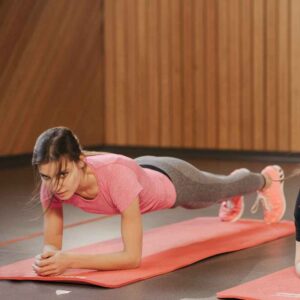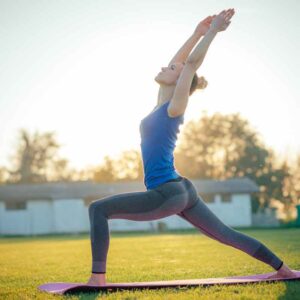8 Yoga Poses for Beginners

In this blog, we’re going to look at eight super important yoga poses for beginners. It doesn’t matter if you’ve never done yoga before or if you want to get better at it – these poses are the perfect way to begin. Let’s discover how these poses can make you feel awesome!
Importance of Yoga for Beginners
Yoga is not just about doing cool poses that look good in pictures, it’s for your health and well-being. Imagine it as a whole package deal for your body and mind! Now, if you’re just starting with yoga, it’s crucial to know why it’s so awesome.
- Yoga isn’t just about exercise, it helps your body and mind work together to make you feel good inside and out.
- It makes your body flexible.
- It helps you reduce stress. It calms your mind and makes you feel relaxed and refreshed.
These are some benefits which I discussed but there are many benefits of it so the more you do yoga, the more you’ll see positive changes in how you feel.
If you are not so confident about how to do yoga in a right way then you can also join Balivinyasayoga school, they will help you to improve your yoga practice.
Selecting the Right Yoga Mat and Clothes
Before we start learning about yoga poses, let’s make sure you’ve got the right stuff.
- Yoga Mat – Yoga mat is very important for yoga learners or practitioners for safety concerns.
- It provides a comfortable and supportive surface for various yoga postures and exercises.
- It is essential for maintaining stability as it prevents slipping, especially during poses that involve balance.
- Yoga mats are versatile and can be used for various styles of yoga, from gentle Hatha to more dynamic Vinyasa or Power Yoga.
2. Yoga Outfit – Wearing comfortable clothing that allows for movement is a crucial aspect of a successful and enjoyable yoga practice.
- Comfortable clothing provides unrestricted movement.
- Discomfort from ill-fitting or distracting clothing can divert attention away from the present moment.
- Feeling comfortable in one’s clothing promotes confidence and body positivity.
Your mat and clothes are like your sidekicks in this yoga adventure. They make sure you’re comfortable and focused on having fun. If your mat supports you, and your clothes let you move freely, you’re all set for a fantastic yoga time.
The 8 Yoga Poses for Beginners
- Mountain Pose (Tadasana) –

Benefits of Mountain Pose:-
- Improves posture and alignment.
- Builds awareness of weight distribution on the feet.
- Promotes grounding and stability.
Steps to do Mountain pose:-
- Stand with your feet together, arms relaxed by your sides.
- Feel your feet on the ground for stability.
- Stretch your arms towards the sky. Keep your fingers reaching, but shoulders relaxed.
- Take a deep breath in, and as you breathe out, imagine all your worries going away.
- Downward-Facing Dog (Adho Mukha Svanasana) –

Benefits of Downward Dog:-
- Stretches the spine, shoulders, and hamstrings.
- Strengthens the arms, shoulders, and legs.
- Enhances overall flexibility.
Steps to do Downward facing dog:-
- Get down on your hands and knees. Keep your wrists under your shoulders and your knees under your hips.
- Tuck your toes under and lift your hips towards the ceiling. Imagine you’re making an upside-down “V.”
- Gently straighten your legs, but don’t lock your knees. Your heels don’t need to touch the ground; it’s okay if they’re lifted a bit.
- Press your palms into the ground. Your arms should be straight, and your shoulders shouldn’t be up by your ears – let them relax.
- Look towards your belly button or between your thighs. Keep your head in line with your arms.
- Take deep breaths. Feel the stretch in your back and the backs of your legs.
- Hang out in this pose for a few breaths, feeling the stretch and strength it brings to your body.
- Plank Pose (Uttihita Chaturanga Dandasana) –

Benefits of Plank pose:-
- Core Strengthening
- Back Strength and Stability
- Improving Posture
Steps to do Plank Pose:-
- Start in a tabletop position with your wrists under your shoulders.
- Step your feet back, keeping your body in a straight line from head to heels.
- Engage your core muscles and press through your palms and the balls of your feet.
- Keep your neck in line with your spine, gaze towards the floor.
- Hold the position, breathing steadily.
- Tree Pose (Vrksasana) –

Benefits of Tree pose:-
- Improves Balance
- Strengthens Leg Muscles
- Stabilizes Hips
- Enhances Concentration
Steps to do Tree pose:-
- Begin standing with your feet together.
- Shift your weight onto one leg.
- Lift the opposite foot and place the sole against the inner thigh or calf of the standing leg.
- Find your balance and bring your palms together in front of your chest or extend your arms overhead.
- Focus your gaze on a fixed point to help with balance.
- Hold the pose and switch sides.
- Child’s Pose (Balasana) –

Benefits of Child’s pose:-
- Relieves Back and Neck Pain
- Stretches Hips and Thighs
- Calms the Mind
- Enhances Digestion
Steps to do Child’s pose (Balasana):-
- Start on your hands and knees in a tabletop position.
- Sit back on your heels, lowering your hips toward your heels.
- Extend your arms forward on the mat or alongside your body.
- Rest your forehead on the mat.
- Relax your neck, shoulders, and back.
- Breathe deeply and hold the pose, feeling a gentle stretch in your back and hips.
- Warrior I (Virabhadrasana I) –

Benefits of Warrior I (Virabhadrasana I):-
- Strengthens Leg Muscles
- Stabilizes Hips and Core
- Opens Chest and Lungs
- Enhances Focus and Concentration
- Builds Endurance
Steps to do Warrior I (Virabhadrasana I):-
- Begin in a standing position, step one foot back, keeping the front knee bent.
- The front foot points forward, and the back foot is at a 45-degree angle.
- Square your hips to face forward.
- Raise your arms overhead, with palms facing each other or hands pressed together.
- Gaze forward or up, lengthening your spine.
- Sink into the front knee, keeping it directly above the ankle.
- Hold the pose and switch sides.
- Forward Fold (Uttanasana) –

Benefits of Forward fold:-
- Stretching the Hamstrings
- Releasing Tension in the Lower Back
- Opening the Hips
- Calming the Nervous System
Steps to do Forward Fold:-
- Start in a standing position with your feet hip-width apart.
- Inhale and lengthen your spine.
- Exhale, hinge at your hips, and bend forward, bringing your chest toward your thighs.
- Let your head hang heavy, and allow your arms to dangle or hold opposite elbows.
- Engage your thighs and gently draw your navel toward your spine.
- Hold the position, breathing deeply and releasing tension in your back and hamstrings.
- Cobra Pose (Bhujangasana) –

Benefits of Cobra pose:-
- Strengthens the Back Muscles
- Improves spinal flexibility
- Stimulates Abdominal Organs
- Elevates Mood and Energy
- Relieves Stress and Fatigue
Steps to do Cobra pose:-
- Start by lying on your stomach with your legs extended and the tops of your feet on the mat.
- Place your palms next to your chest, fingers pointing forward.
- Inhale, press into your hands, and lift your head, chest, and abdomen off the mat.
- Keep your elbows slightly bent and your shoulders away from your ears.
- Engage your back muscles and lift through your chest, keeping your gaze forward or slightly upward.
- Hold the pose for a few breaths, then exhale as you lower back down.
Conclusion
These ten poses are like your secret keys to making your body and mind feel awesome. Whether you’re reaching for the sky in Mountain Pose, bending like a graceful tree in Tree Pose, or giving yourself a little break in Child’s Pose, each pose has its own magic.
So, as you continue on this yoga journey, remember: it’s all about you. Your yoga mat is your special place to discover a healthier, happier you.
If you want to learn yoga you can also join yoga retreats like 7 day yoga retreat or 100 Hour Yoga Teacher Training as a basic course of yoga.

One Comment